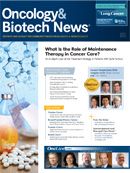Publication
Article
Oncology & Biotech News
Worldwide Effort Yields Major Advances in Identifying Genetic Risks for Breast, Prostate, and Ovarian Cancer
Author(s):
A large, international study has yielded a wealth of new information about genetic alterations that can increase an individual's risk of breast, prostate, and ovarian cancer.
Douglas Easton, PhD
A large, international study under the auspices of the Collaborative Oncological Gene-environment Study (COGS) network has yielded a wealth of new information about genetic alterations that can increase an individual’s risk of breast, prostate, and ovarian cancer.
COGS is a European Union—based consortium established in 2009 to provide a detailed evaluation of gene–environment interactions and their associations with tumor phenotypes and disease outcomes. One of the major goals of the project has been a more detailed mapping of susceptibility loci previously linked to these three hormone-related cancers through genotyping a very dense panel of markers.
It is expected that the research will help identify individuals most at risk for breast, prostate, and ovarian cancer, and thus would benefit from appropriate interventions, such as increased screening, adjusting lifestyle factors, or prophylactic therapy. The COGS network includes 160 research groups from around the world, including 30 from the United States.
The research findings were released in 13 reports featured in a special issue of Nature Genetics; articles also have been published in PLOS Genetics and other journals. The results are based on genetic analyses of selected sections of DNA obtained from 200,000 individuals (a control group of 100,000 healthy individuals and 100,000 patients with breast, ovarian, or prostate cancer).
Researchers found significant alterations (single nucleotide polymorphisms [SNPs]) in the composition of the nitrogen bases A, G, C, and T in the DNA samples of patients with cancer compared with samples from healthy controls. These differences also are sometimes referred to as “spelling mistakes” or “genetic typos.” SNPs are the most common type of change in DNA, occurring when a single nucleotide is replaced with another.
In breast cancer, the researchers identified 49 SNPs—twice as many as previously found—and 41 new susceptibility loci. Investigators also gathered additional evidence for the presence of distinct pathways for ER-positive and ER-negative breast cancer, with the finding that SNPs at four loci were linked to ER-negative breast cancer, but not the ER-positive type.
Twenty-six additional SNPs were found to be associated with prostate cancer, as well as 23 new susceptibility loci, meaning that 78 prostate cancer susceptibility loci have now been identified, accounting for approximately 30% of familial prostate cancer risk. Thirteen SNPs demonstrated a clear association with aggressive disease. Study authors noted that these findings will facilitate population risk stratification for clinical studies. The top 1% of the risk distribution, for example, has a 4.7-fold higher risk for disease than the average of the population profiled.
For ovarian cancer, the research uncovered three new loci associated with risk, two for all epithelial ovarian cancer subtypes, and another one specific to a more serious subtype. An additional locus was found to be associated with ovarian cancer risk for BRCA1 mutation carriers only. Two susceptibility loci previously associated with ovarian cancer also were validated as a result of the research. The total number of known ovarian cancer susceptibility loci is now 12.
In addition, investigators were able to identify 1000 additional SNPs that might influence the risk of breast cancer and 2000 which may have a role in prostate cancer, described as “an equally important finding,” by Per Hall, professor at Karolinska Institutet in Sweden and the coordinator of the COGS consortium, in a statement. “We also have a picture of where in the genome we should look in future studies.”
“We’re now on the verge of being able to use our knowledge to develop tests that could complement breast cancer screening and take us a step closer to having an effective prostate cancer screening program,” said Douglas Easton, PhD, professor at the University of Cambridge and director of the Cancer Research UK Genetic Epidemiology Group, who led several of the recently published studies.
Findings from the Collaborative Oncological Gene-environment Study, as well as commentary and primers on the research, can be found in the April 2013 issue of Nature Genetics (iCOGS Focus), available at http://www.nature.com/icogs.










